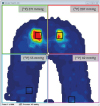1. Horak FB. Clinical assessment of balance disorders. Gait Posture. 1997; 6:76–84.

2. Kim EJ. Assessment of balance and posture in brain disorders. Brain Neurorehabil. 2013; 6:58–63.

3. Jung HY, Kim TH, Park JH. Relationship between Berg balance scale and functional independence measure in stroke patients. J Korean Acad Rehabil Med. 2005; 29:167–170.
4. Hsieh CL, Sheu CF, Hsueh IP, Wang CH. Trunk control as an early predictor of comprehensive activities of daily living function in stroke patients. Stroke. 2002; 33:2626–2630.


5. Verheyden G, Nieuwboer A, Van de Winckel A, De Weerdt W. Clinical tools to measure trunk performance after stroke: a systematic review of the literature. Clin Rehabil. 2007; 21:387–394.

6. Jung HY, Park JH, Shim JJ, Kim MJ, Hwang MR, Kim SH. Reliability test of Korean version of berg balance scale. J Korean Acad Rehabil Med. 2006; 30:611–618.
7. Poole JL, Whitney SL. Motor assessment scale for stroke patients: concurrent validity and interrater reliability. Arch Phys Med Rehabil. 1988; 69:195–197.

8. Tyson SF, Connell LA. How to measure balance in clinical practice. A systematic review of the psychometrics and clinical utility of measures of balance activity for neurological conditions. Clin Rehabil. 2009; 23:824–840.


9. Srivastava A, Taly AB, Gupta A, Kumar S, Murali T. Post-stroke balance training: role of force platform with visual feedback technique. J Neurol Sci. 2009; 287:89–93.


12. Perlmutter S, Lin F, Makhsous M. Quantitative analysis of static sitting posture in chronic stroke. Gait Posture. 2010; 32:53–56.


13. Li W, Yu S, Yang H, Pei H, Zhao C. Effects of long-duration sitting with limited space on discomfort, body flexibility, and surface pressure. Int J Ind Ergon. 2017; 58:12–24.

14. Kyung G, Nussbaum MA. Driver sitting comfort and discomfort (part II): relationships with and prediction from interface pressure. Int J Ind Ergon. 2008; 38:526–538.

15. Jung HY, Park BK, Shin HS, Kang YK, Pyun SB, Paik NJ, Kim SH, Kim TH, Han TR. Development of the Korean version of Modified Barthel Index (K-MBI): multi-center study for subjects with stroke. J Korean Acad Rehabil Med. 2007; 31:283–297.
16. Salbach NM, Mayo NE, Higgins J, Ahmed S, Finch LE, Richards CL. Responsiveness and predictability of gait speed and other disability measures in acute stroke. Arch Phys Med Rehabil. 2001; 82:1204–1212.


17. Blum L, Korner-Bitensky N. Usefulness of the Berg balance scale in stroke rehabilitation: a systematic review. Phys Ther. 2008; 88:559–566.


18. Hama S, Yamashita H, Shigenobu M, Watanabe A, Hiramoto K, Takimoto Y, Arakawa R, Kurisu K, Yamawaki S, Kitaoka T. Sitting balance as an early predictor of functional improvement in association with depressive symptoms in stroke patients. Psychiatry Clin Neurosci. 2007; 61:543–551.


19. Verheyden G, Nieuwboer A, De Wit L, Thijs V, Dobbelaere J, Devos H, Severijns D, Vanbeveren S, De Weerdt W. Time course of trunk, arm, leg, and functional recovery after ischemic stroke. Neurorehabil Neural Repair. 2008; 22:173–179.


20. Cholewicki J, Polzhofer GK, Radebold A. Postural control of trunk during unstable sitting. J Biomech. 2000; 33:1733–1737.

21. Hwang JH, Park DS, Cho NS, Chang HJ, Lee YT, Piao YJ, Kwon TK. Reliability of dynamic posturography with unstable platform to evaluate seated postural control. J Korean Acad Rehabil Med. 2007; 31:394–399.
22. Lim KB, Kim DY, Lee KT. Influence of hemispatial neglect on trunk control in stroke patients. J Korean Acad Rehabil Med. 2009; 33:463–469.
23. Yoon K, Lee KW, Kim SB, Kwak H, Kim JW, Cheon SM, Lee GC, Kim WB. Computerized analysis of postural instability in Parkinson's disease. J Korean Acad Rehabil Med. 2007; 31:176–181.
24. Lim KB, Na YM, Lee HJ, Joo SJ. Comparison of postural control measures between older and younger adults using balance master system. J Korean Acad Rehabil Med. 2003; 27:418–423.
25. Liston RA, Brouwer BJ. Reliability and validity of measures obtained from stroke patients using the balance master. Arch Phys Med Rehabil. 1996; 77:425–430.


26. Yoon JY, Kim KM, Chang MY, Yoo WG, Oh JS, An DH. Foot pressure and trunk muscle activity during reaching tasks performed by seated hemiplegia patients. J Phys Ther Sci. 2011; 23:525–529.

27. In : Kozniewski BS, Cezeaux JL, editors. Wheelchair pressure monitoring alert system for the reduction of the occurrence of pressure sores. 2011 IEEE 37th Annual Northeast Bioengineering Conference (NEBEC 2011); 2011 Apr 1–3; Troy, NY. Piscataway: IEEE;2011. 04. p. 413.
28. Cifu DX, Stewart DG. Factors affecting functional outcome after stroke: a critical review of rehabilitation interventions. Arch Phys Med Rehabil. 1999; 80:S35–S39.

29. Laufer Y, Sivan D, Schwarzmann R, Sprecher E. Standing balance and functional recovery of patients with right and left hemiparesis in the early stages of rehabilitation. Neurorehabil Neural Repair. 2003; 17:207–213.


30. Sackley CM. Falls, sway, and symmetry of weight-bearing after stroke. Int Disabil Stud. 1991; 13:1–4.


31. Chen CL, Tang FT, Chen HC, Chung CY, Wong MK. Brain lesion size and location: effects on motor recovery and functional outcome in stroke patients. Arch Phys Med Rehabil. 2000; 81:447–452.


32. Pantano P, Formisano R, Ricci M, Di Piero V, Sabatini U, Di Pofi B, Rossi R, Bozzao L, Lenzi GL. Motor recovery after stroke. Morphological and functional brain alterations. Brain. 1996; 119:1849–1857.

33. Kunesch E, Binkofski F, Steinmetz H, Freund HJ. The pattern of motor deficits in relation to the site of stroke lesions. Eur Neurol. 1995; 35:20–26.

34. Heilman KM, Bowers D, Valenstein E, Watson RT. The right hemisphere: neuropsychological functions. J Neurosurg. 1986; 64:693–704.


35. Hamrin E, Eklund G, Hillgren AK, Borges O, Hall J, Hellström O. Muscle strength and balance in post-stroke patients. Ups J Med Sci. 1982; 87:11–26.


36. Kligyte I, Lundy-Ekman L, Medeiros JM. Relationship between lower extremity muscle strength and dynamic balance in people post-stroke. Medicina (Kaunas). 2003; 39:122–128.
37. Sandin KJ, Smith BS. The measure of balance in sitting in stroke rehabilitation prognosis. Stroke. 1990; 21:82–86.















 PDF
PDF Citation
Citation Print
Print



 XML Download
XML Download